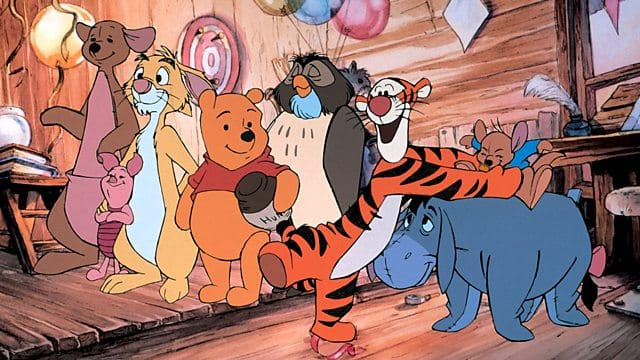The tales of Winnie the Pooh have captured the hearts of millions for years, no matter what age. It is set against the backdrop of the hundred-acre wood and features a cast of sweet characters that bring joy and lessons to younger generations.
Yet, we need all the fun and adventure that lies in a layer of complexity that relates to humans and their emotional intricacies.
In this exploration, we will dive into Winnie the Pooh’s mental illnesses and his endearing companions to understand their deeper psychological understandings.
While Winnie the Pooh is a seemingly innocent character, his obsession with Piglet’s anxiety and Eeyore’s melancholy is something that adult human beings will find relatable.
A thorough analysis of these beloved characters is what we will be seeing in this article. Join us as we embark on a journey through the hundred-acre wood and peel back the layers to explore the different psychological dimensions of these characters.
The Whimsical World of Winnie the Pooh

At the heart of this charming world is Winnie the Pooh, the honey-loving bear with an endearing innocence that resonates with audiences of all ages.
Pooh’s unwavering loyalty, childlike wonder, and relatable quirks make him a relatable and lovable character, often finding himself in whimsical predicaments that provide both laughter and life lessons.
Beside Pooh resides Piglet, a timid and anxious creature whose small stature belies a heart brimming with courage and warmth. Then there’s Eeyore, the gloomy donkey whose subdued demeanor gives him a distinctive charm.
Despite his persistent sadness, Eeyore’s interactions with his friends highlight the importance of empathy, understanding, and the power of companionship.
Rabbit, on the other hand, epitomizes order and organization, often finding himself caught in humorous misadventures due to his meticulous planning.
Owl, the wise and verbose resident of the wood, imparts knowledge and guidance to his friends, albeit sometimes with a touch of eccentricity. His tangential explanations offer a touch of humor and wisdom to the tales.
Lastly, Kanga and Roo symbolize the nurturing and protective bonds of caregiving, showcasing the tender connections between a mother and her child.
As we embark on an exploration of these endearing characters, we invite you to delve into the whimsical world of Winnie the Pooh, where each character’s unique traits and adventures relate to different mental illnesses.
Detailing Each Character and the Associated Mental Illness
1. Winnie the Pooh: The Concern of Obsessive Hunger

Winnie the Pooh, the lovable bear with an insatiable appetite for honey, is a character that has captured the hearts of generations.
While his love for honey is often depicted in a humorous light, a close examination reveals certain traits that could be associated with Obsessive-Compulsive Disorder (OCD).
OCD is characterized by a cycle of obsession, followed by unusual and distressing thoughts, which are released by repetitive behaviors. These compulsions help in reducing the anxiety of the person.
Winnie Pooh’s mental illness is characterized by his relentless fixation on honey and his routines. The unwavering focus on obtaining honey often leads to repeated behaviors like visiting favorite sports and using various methods for extracting honey.
As we dive deeper, we get to see that Pooh’s distress when he is not able to acquire Honey is followed by a stern determination to find it. His relationship with honey is quite similar to anyone having a repetitive action as a means of calming anxiety.
He feels compelled to engage in these rituals to reduce his anxiety and alleviate emotional discomfort. This dynamic highlights the underlying similarity between his actions and compulsive behaviors associated with OCD.
2. Piglet: Unmasking anxiety
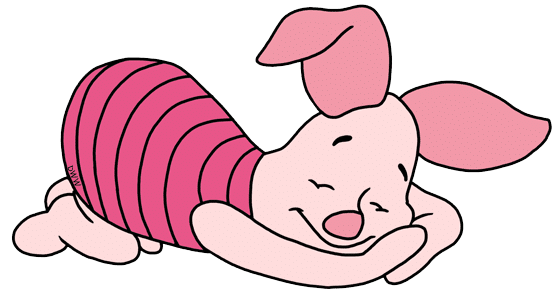
Piglet, the timid and anxious character from the Winnie the Pooh stories, presents a portrayal that resonates with individuals who grapple with anxiety disorders.
Piglet’s chronic worry, exaggerated fears, and hesitance in new situations offer a glimpse into the world of anxiety disorders, particularly Generalised Anxiety Disorder (GAD) and Social Anxiety Disorder.
Generalized Anxiety Disorder is characterized by persistent and excessive worrying about various aspects of life. Piglet’s tender fret over even the most mundane scenarios aligns with GAD’s hallmark of pervasive worry.
His irrational fears, such as the infamous Heffalumps and Woozles, echo the disproportionate anxieties that individuals with GAD often experience.
His hesitation to engage in new experiences and his fear of social interactions are similar to the characteristics of Social Anxiety Disorder.
His reluctance to join in activities or his concerns about being judged by others reflect the underlying fear of negative evaluation that individuals with social anxiety grapple with.
While Piglet’s character adds charm and humor to the stories, it’s important to recognize the underlying theme of anxiety that he represents. By showcasing Piglet’s challenges and growth, the Winnie the Pooh tales offer a relatable depiction of anxiety that can foster empathy and understanding.
Just as Piglet’s friends support and encourage him, these stories emphasize the significance of a supportive environment for individuals dealing with anxiety disorders.
It’s essential to approach this analysis with sensitivity, acknowledging that the intention behind Piglet’s character is to create relatable narratives rather than clinical diagnoses.
3. Eeyore: Navigating Depths of Depression
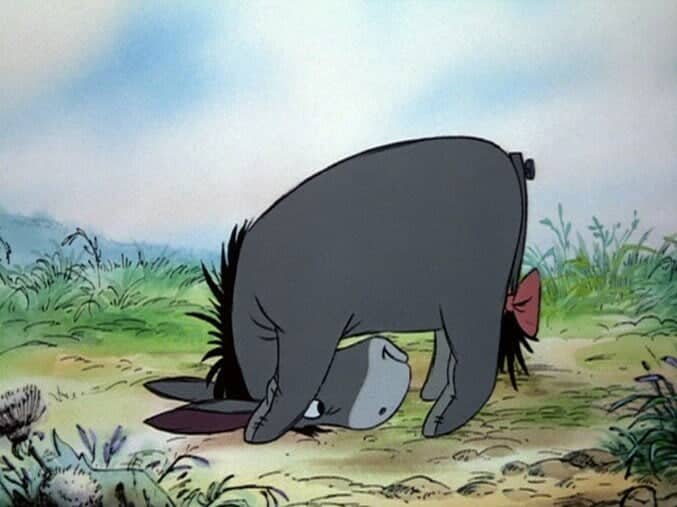
A gloomy donkey in the happy world of Winnie the Pooh embodies a character whose outlook is quite similar to the complexities of major depressive disorder.
The perpetual sadness and hopelessness offer a poignant depiction of mental illness experienced by individuals dealing with depression.
Major depressive disorder is characterized by perpetual feelings of sadness, loss of interest, and a pervasive sense of despair. Eeyore’s continuous state of melancholy shows the emotional weight that comes with his depression.
Self-deprecating humor is an introspective tendency often seen in individuals struggling with MDD. They always tend to see themselves through a distorted and critical lens.
His detachment and sense of isolation further confirm the features of depression. This portrayal of mental illness highlights the challenge of maintaining connections and doing activities that were once enjoyable while struggling with your inner self.
While he generally interacts with his friends regularly, one can always see some subtle complexities in his behavior.
4. Tigger: Hyperactivity and Impulsiveness
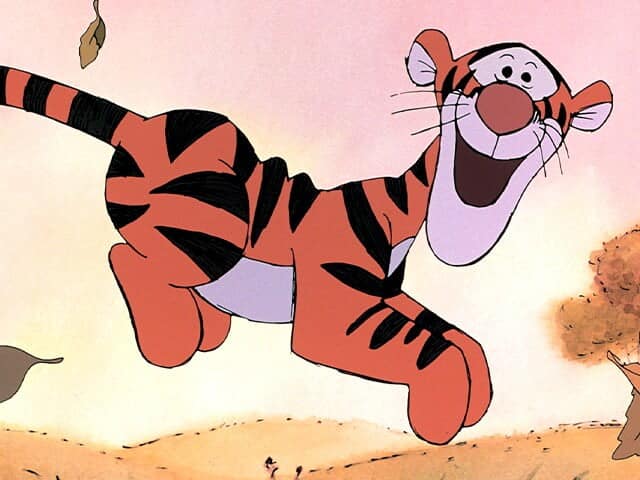
The bouncy and exuberant Tigger reflects the traits of attention deficit hyperactivity disorder (ADHD). His energy knows no limitations, and impulsive behavior provides an intriguing exploration into the world of ADHD.
ADHD is marked by symptoms such as short-term attention, hyperactivity, and impulsivity. Tigger’s constant energy and his inability to sit still are some of the most common characteristics of ADHD.
A key trait being his tendency to dive into situations without thinking confirms the mental illness.
His quick shifts of attention and inability to stay interested in one thing resonate with the challenge that individuals with ADHD often face. His personality is lively and charming, but it also showcases the struggle of managing the impulses of people suffering from ADHD.
The constant urge to be loud or obnoxious to gain attention is commonly seen in children but also among adults.
5. Rabbit: Perfectionism and Order
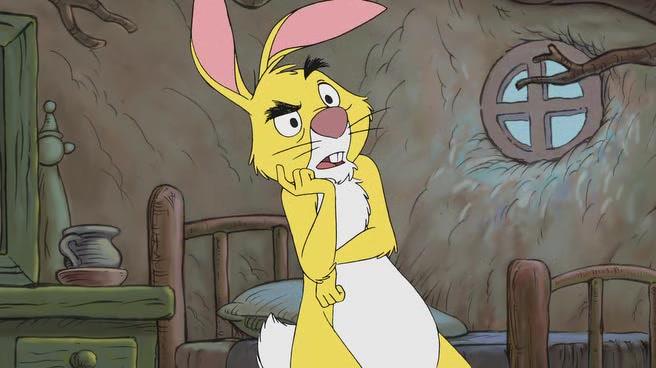
Rabbit, the organized and pragmatic character in Winnie the Pooh, showcases tendencies that resonate with the characteristics of Obsessive-Compulsive Personality Disorder (OCD).
His strong desire for order, perfectionism, and need for control provides an insightful exploration into the world of OCPD.
Obsessive-Compulsive Personality Disorder involves an obsession with orderliness, perfectionism, and control that can hinder flexibility and spontaneity. Rabbit’s meticulous organization and insistence on maintaining order in the Hundred Acre Wood reflect the traits of OCPD.
His tendency to become anxious or irritated when things don’t go his way is similar to the distress that individuals with OCPD may experience during disorder and chaos.
Rabbit’s difficulty in delegating tasks and his rigid adherence to routines mirror the hallmark characteristics of OCPD. His emphasis on following established procedures and aversion to change reflects the underlying struggle of individuals with this personality trait.
6. Owl: Attention-Deficit Wisdom
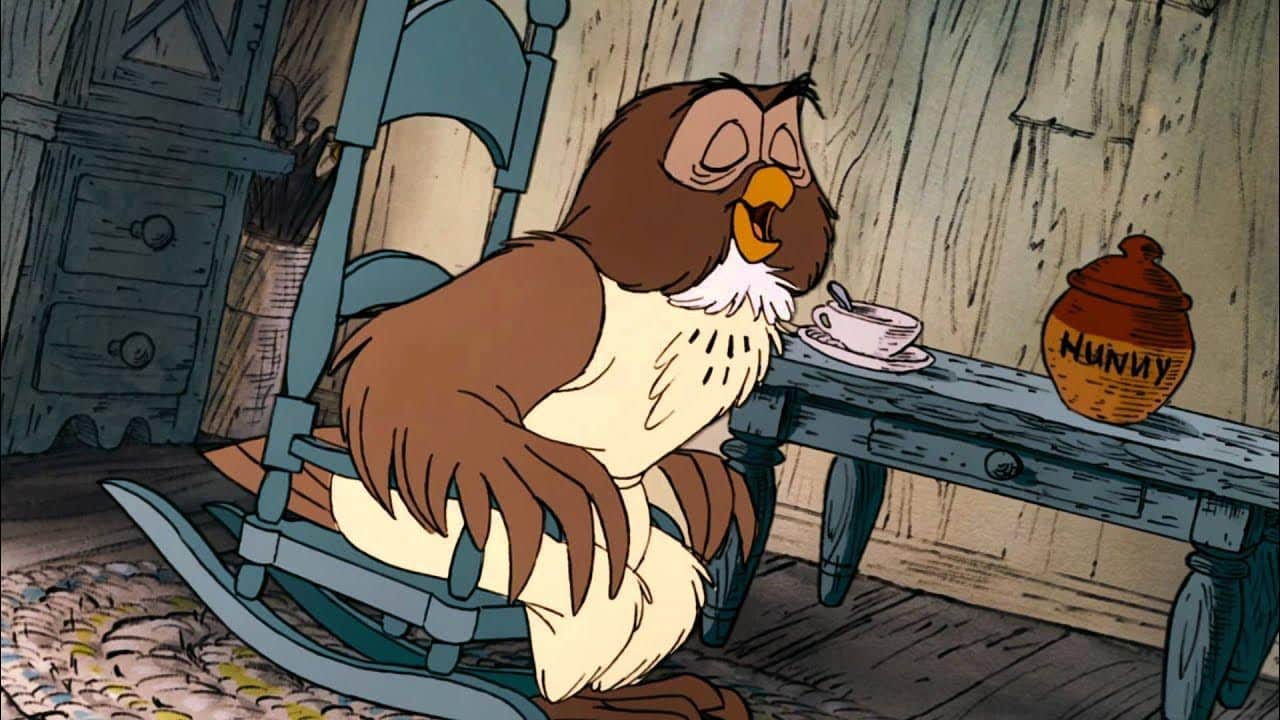
Owl, the knowledgeable and verbose character in the Winnie the Pooh series, exhibits traits that could be associated with Attention-Deficit Disorder (ADD).
His scattered thought process, tangential explanations, and difficulty maintaining focus provide a fascinating exploration into ADD. He tends to deflect from the topic of interest and dive into different topics, which is one of the foundational characteristics of ADD.
Attention-Deficit Disorder involves challenges in sustaining attention, staying organized, and following through on tasks. Owl’s tendency to provide lengthy, convoluted explanations that often veer off track aligns with the distractibility and difficulty maintaining focus seen in individuals with ADD.
His sporadic thought patterns and rapid topic shifts mirror the impulsiveness that can accompany ADD.
Owl’s eccentricity and habit of rambling through his narratives might reflect his attempts to keep his thoughts on track. His humorous tangents highlight the underlying struggle individuals with ADD experience in managing their attention and organizing their ideas.
7. Kang and Roo: The Nurturing Caregiver

Kanga and Roo, the nurturing and protective characters in the Winnie the Pooh series, represent the roles of caregivers and the dynamics of attachment.
While their roles do not necessarily reflect specific psychological disorders, they offer a lens to understand the complexities of caregiving and the bonds formed within families.
Kang, as a motherly figure, showcases unconditional love and support for her son Roo. Her attentiveness to Roo’s needs and her guidance mirror the qualities of a nurturing caregiver. Roo, in turn, represents the child seeking security and connection through his bond with his mother.
Kanga, as a motherly figure, showcases unconditional love and support for her son Roo. Her attentiveness to Roo’s needs and her guidance mirror the qualities of a nurturing caregiver.
Roo, in turn, represents the child seeking security and connection through his bond with his mother.
Approach Towards Analysis
Winnie the Pooh, a beloved literary and animated creation, offers more than meets the eye. An analytical exploration of its characters unveils a multi-dimensional world that reflects a range of personalities, emotions, and human experiences.
This analytical lens not only deepens our understanding of these characters but also provides insights into the complexities of human nature.
An analytical approach to Winnie the Pooh characters reveals a literary treasure trove teeming with psychological nuances, archetypal representations, and socio-cultural commentaries.
While it’s important to approach these analyses with sensitivity and the understanding that the characters are fictional creations, their traits provide a unique lens through which to examine various mental health aspects.
Winnie the Pooh’s canvas is a reminder that literature and storytelling have the power to reflect the diverse tapestry of human emotions and experiences.
Conclusion
In the fun and fantastical realm of the Hundred Acre Wood, the characters of Winnie the Pooh’s mental illnesses tell us more than adventure stories.
From Pooh’s obsessions to Piglet’s anxieties, Eeyore’s melancholy, Tigger’s exuberance, Rabbit’s perfectionism, Owl’s eccentricity, and the nurturing bonds of Kanga and Roo, each character portrays a different aspect of mental illness and the human psyche.
The tales of Winnie the Pooh transcend generations and continue to captivate audiences with their charm, humor, and depth. They remind us that beneath the whimsy lies a rich tapestry of emotions that resonate across time and cultures.
As we bid farewell to the Hundred Acre Wood, let us carry forward the lessons of compassion, understanding, and the significance of exploring the complexities that make us uniquely human.

